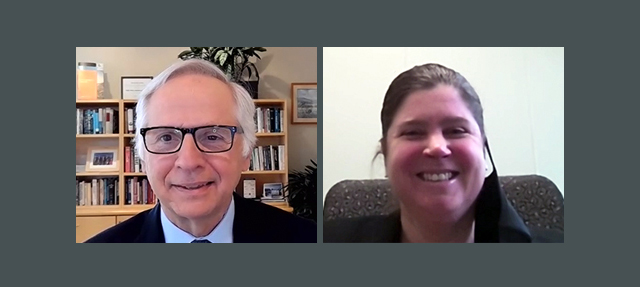Protecting public health during the pandemic while getting dollars into people’s hands involves partnerships. As cabinet secretary to Governor Newsom, Ana Matosantos has cultivated partnerships at all levels to address the repercussions of COVID-19. Matosantos spoke with Mark Baldassare, PPIC president and CEO, on managing the pandemic crisis and the steps California is taking towards an equitable recovery.
Matosantos said she starts most days with a meeting convened by the chief of staff, where COVID-19 dominates policy discussion. In the December PPIC Statewide Survey, the public mirrored these concerns. “About two in three Californians said they are worried that the coronavirus will negatively affect their family’s finances,” Baldassare said. “Getting the economy back on track will depend on combatting the latest COVID-19 surge.”
The state has partnered with local government, health care providers, businesses, and labor organizations, among others, to confront the rise in cases. “The administration has consistently been working on an approach based on health and data first,” Matosantos said. Data led the state to reissue regional stay-at-home orders. Efforts toward a slow and steady reopening focus on not overburdening the health care system.
A COVID-19 vaccine will likely move the state closer to reopening. California receives the first 327,000 vaccine doses this week, with an estimated 2.1 million doses expected during December. To engage communities who are reluctant about getting the vaccine, such as Black and Latino communities, a community advisory committee will determine a public education strategy; another committee will conduct an independent assessment to verify the vaccine is safe.
Opportunities can arise from a crisis, and Matosantos noted how COVID-19 has accelerated certain policy trends. One example is in higher education, where the switch to distance learning may give students access to more affordable education—and having both in-person and online learning could expand access to institutions. Another example is the unprecedented level of emergency federal funds to address homelessness, which led to Project Roomkey, a program to house unsheltered Californians.
The pandemic has revealed threats as well, such as problems at the Employment Development Department. The Pandemic Unemployment Assistance program paid out over $100 billion to Californians, but the program battled fraud as a rise in caseloads led to backlogs. Matosantos noted that changes are now in place to ensure effective ID verification, and the state has launched an intensive process to reduce backlogs by the end of January.
And while California is in a better fiscal position than projected in June, strong state revenues reflect the disproportionate impact the recession has had on the lowest-income Californians. Future policy actions by the legislature, therefore, will focus on bringing about a more inclusive recovery.
Talks with her grandmother about living through the Great Depression have offered Matosantos perspective on governing through a recession, and for Matosantos the outlook for California is bright: “We endure and we persist and we come out the other side. What gives me hope is that we’re going to be stronger.”



